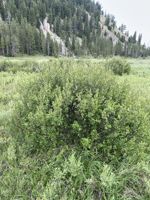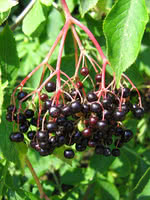Mon-Fri 9am - 5pm Mountain time
Black Elderberry vs Dwarf-Bog Birch
Betula glandulosa
Sambucus canadensis
CUSTOM GROW
NOT AVAILABLE THIS SEASON - MIGHT RETURN
Dwarf-Bog Birch is a native, cold-hardy shrub that can be found across most of Canada. Its preference for moist soils and the extensive root system make it well-suited for riparian zone plantings, soil stabilization, and erosion control projects.
It features small, round, leathery leaves with scalloped edges and produces small, cone-like catkins. A distinguishing characteristic of the Dwarf-Bog Birch is the presence of large resin glands on the branches and the undersides of the leaves. These resin glands are the reason for its scientific name, Betula glandulosa.
Note: We use Dwarf-Bog Birch for Betula glandulosa. This species is also known by many other common names, including Bog Birch, Dwarf Birch, Glandular Birch, and others. Please confirm the scientific name to ensure you are ordering the correct plant.
Black Elderberry is a deciduous shrub native to eastern North America. You can plant this shrub in moist areas and it will help stabilize your soil. You can also use it on rural properties anywhere you'd use a lilac.
Black Elderberries are considered to be partially self-pollinating. So while they will still produce some berries without cross-pollination, planting with another variety will increase yields. Consider planting with Ranch Elderberry or Bob Gordon Elderberry.
Warning: the seeds, stems, leaves, roots, and uncooked berries of the Black Elderberry are poisonous to humans when eaten in quantity. You should cook the berries to make them safe for human consumption.
Dwarf-Bog Birch Quick Facts
Black Elderberry Quick Facts
Toxicity: leaves, stems, and uncooked berries are poisonous to humans

